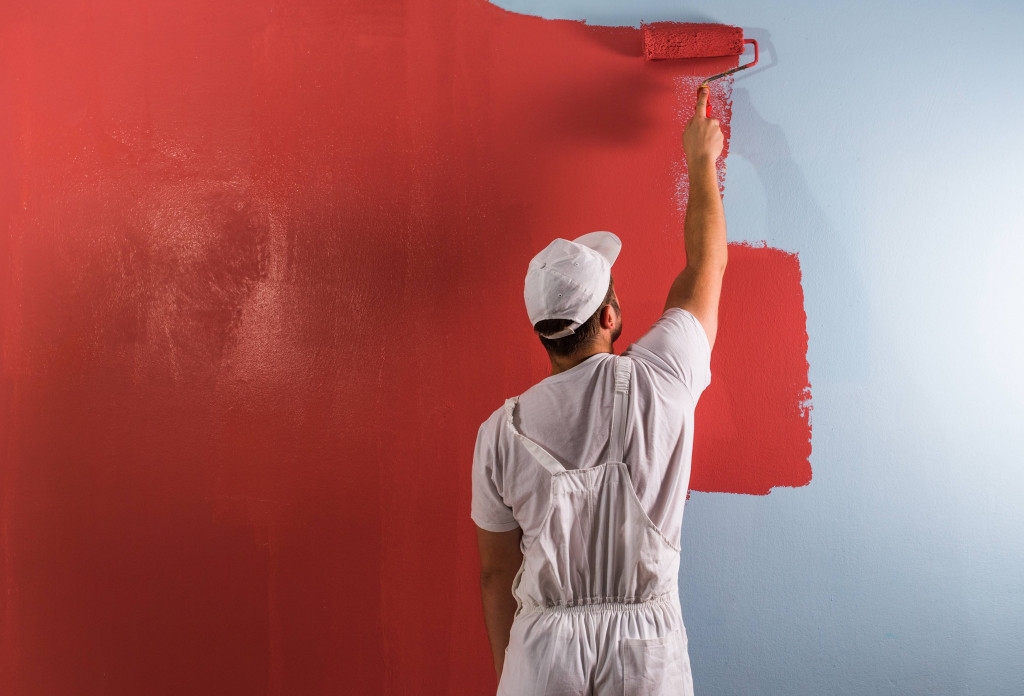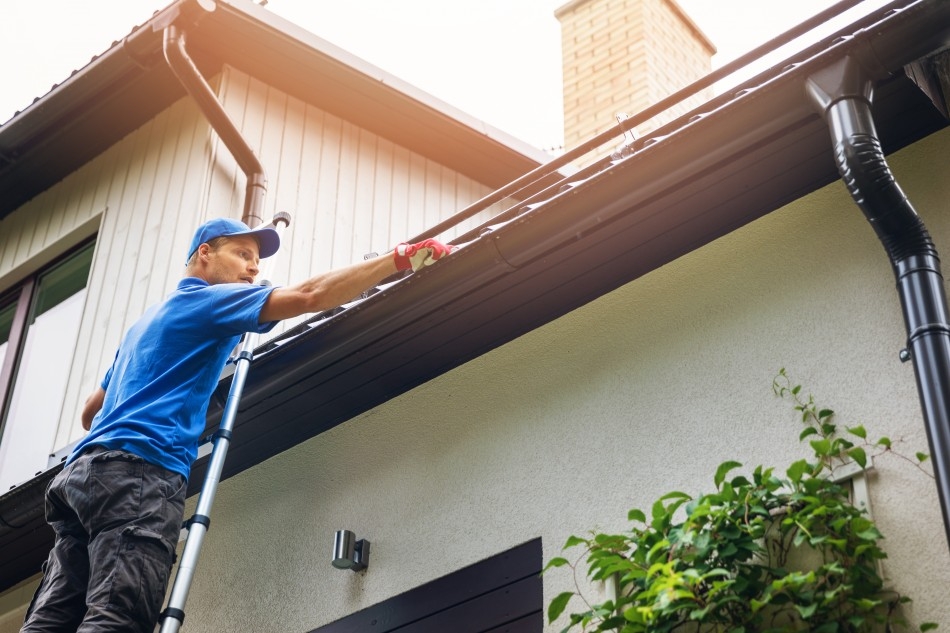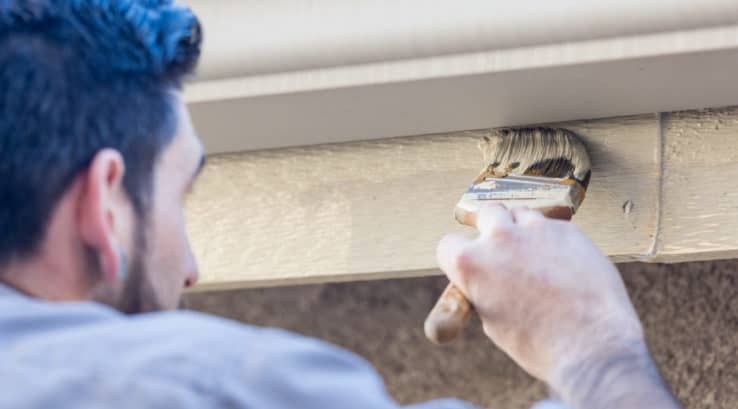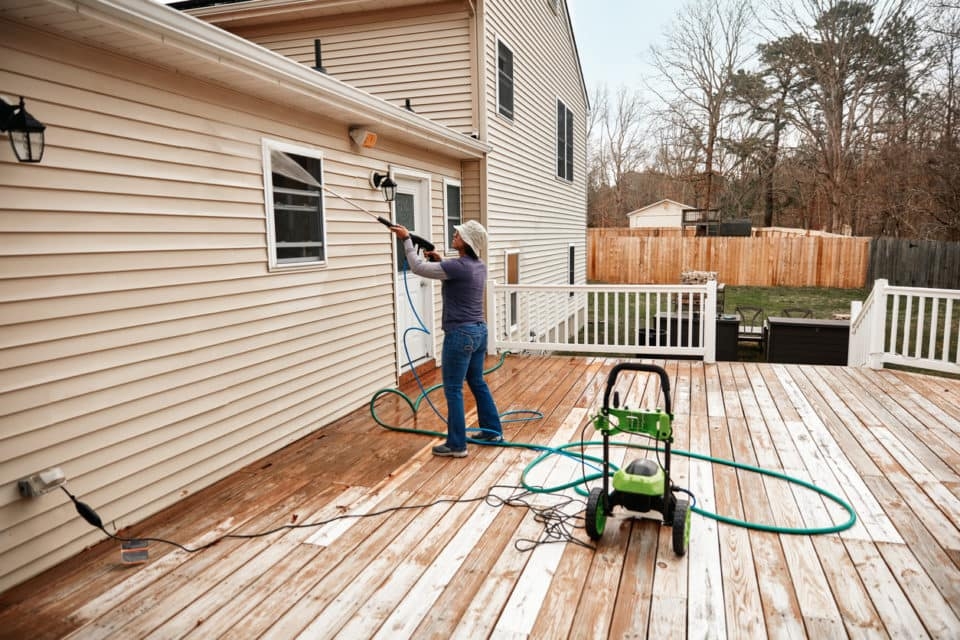

Painting a house is an important job, and it's best left to professionals. House painters can provide homeowners with the perfect color scheme for their homes (inside or out). With so many options available, there's no reason not to find the perfect hue! But it isn't just about the aesthetics; professional house painters are also able to ensure that your walls remain in excellent condition. They have the skills and experience needed to prep surfaces properly, apply protective coatings, and address any underlying issues that could compromise your paint job down the line.
Additionally, good house painters know how to work quickly yet carefully (which can save time and money). Plus, they often use high-quality products which are designed to last longer than lower quality brands. Furthermore, these experts will clean up after themselves when they're done – leaving you with a beautiful space without any added hassle.
Despite all of this, it's still important for homeowners to do their research before hiring a particular service provider. Ask around for referrals from friends or family members who have had successful painting experiences in the past. Additionally, read reviews online to get an idea of what other customers think of each company's services (and prices!). In addition, make sure that any potential painter is fully insured and licensed before signing on the dotted line! Ultimately though, if you want great results – go with a professional house painter!
Painting services can be a great way to spruce up any home (or office)! Not only that, but it can also give a new lease of life to tired, old walls. It's important to choose the right painting service, though – otherwise you could end up with disastrous results!
When looking for a painting service, there are several things to consider. Firstly, the cost; make sure you get an estimate beforehand and compare prices between different companies. Secondly, check out reviews from previous customers; this may help you gain an idea of the quality of work. Lastly, always ask about the materials they'll use - using quality paint will ensure your walls look good for longer!
Once you've found the perfect painting service (or team!), it's time to discuss your project needs in detail. Do you want them to take care of everything or just part of it? Does the job require any special techniques? Don't forget to mention if there are any areas that need extra attention.
Finally, don't be afraid to let your imagination run wild! If there's something unique or creative that you'd like done then let them know – experienced painters should have no problem executing your vision. With their help and expertise, you're sure to achieve stunning results! So why not go ahead and give those walls a fresh coat today?

Painting your home can give it a fresh, new look that will wow anyone who comes to visit!. But with the cost of professional house painters, it may seem like an impossible feat. (Fortunately,) there are ways you can make your home look brand new without breaking the bank.
First and foremost, consider doing some of the work yourself.
Posted by on 2023-10-05

Choosing a professional house painter can be a daunting task. (However,) with the right knowledge and tips, you can easily find an experienced painter who will do a great job for you!. Firstly, ask your friends and family if they have any recommendations.
Posted by on 2023-10-05

Preparing your home before painting can seem like a daunting task, but with the right tips and tricks it doesn't have to be!. Start by clearing away any furniture or decorations (unless they're too heavy to move).
Posted by on 2023-10-05

Painting your home is a great way to freshen up its look without spending a fortune.. It may seem like an overwhelming task, but with quality house painting services you can have the job done quickly and easily!
Posted by on 2023-10-05
Paint companies (are) an invaluable resource for any homeowner or business owner who wants to spruce up their property. But finding the right painting company can be a daunting task! There's no substitute for doing research and asking around; it's important to get references from satisfied customers.
And once you've found a few good leads, it's time to start evaluating each one. Quality of work should be your top priority — is the paint job neat and even? Are there any drips or runs? How does the finished product compare with what was promised? It pays to double-check!
Moreover, cost (isn't) always the deciding factor when choosing a painter. You want someone who will finish on time and within budget but don't necessarily go with the lowest bid just because it's lower. Additionally, consider whether they use high-quality paints and materials — this could make a big difference in how long your paint job lasts.
Still, customer service also matters. Do they respond quickly when you call or email them? Are they willing to answer questions or address concerns? Above all else, look for a company that stands behind its work: if something goes wrong after they leave, are they willing to put it right?
In conclusion, selecting a painting company involves careful consideration of many factors; however, taking the time (to) do your homework can pay off in peace of mind and beautiful results!


Painting contractors can make a huge difference when it comes to giving your home a fresh, new look. These professionals provide services such as interior and exterior painting, staining, varnishing, and more! They know exactly what kind of paint to use for the job, which can save you time and money. Plus, they have the experience necessary to get the job done correctly – no amateur painting here!
However (transition phrase), there are some important factors to consider when hiring a painting contractor. First off, check their credentials and reviews from previous customers. You want to make sure that they have excellent customer service and a long history of successful projects. Secondly, ask them questions about their methodologies – what type of paint do they use? Do they follow safety protocols? Finally, compare prices with other contractors in your area; don't overpay for quality work.
It's also wise to verify that the contractor is insured and bonded so that any accidents or damage during the project will be covered! Don't forget: communication is key throughout this process for optimal results. Be sure to discuss all expectations beforehand so everyone is on the same page. With proper research and due diligence, you'll find an excellent painting contractor who will make your vision become reality!

Power washing services (provide an excellent way to clean) a variety of surfaces. Not only can it be used to freshen up the exterior of a home or business, but it can also be used to remove gum and graffiti from sidewalks, decks, and other outdoor areas. It's fast, effective, and safe for most surfaces! Power washing uses highly pressurized water that is sprayed in a powerful stream to remove dirt, grime, mold, mildew, and more.
Plus, power washing requires no chemicals - meaning it's environmentally friendly! This is great news since traditional cleaning methods often rely on harsh soaps and detergents that can damage vegetation or pollute waterways when they enter storm drains. As a result (power washing has become increasingly popular). In fact, many homeowners choose to have their homes power washed at least once a year.
However (there are still some important considerations). For example, certain types of siding should not be exposed to high-pressure water. Additionally, windows must be thoroughly sealed prior to pressure washing in order to prevent potential water damage inside the home. And lastly - it's important to hire an experienced professional who knows how to operate the equipment safely and efficiently!
In conclusion (power washing provides an excellent way to keep your property looking great). With its eco-friendly approach and impressive results - there's really no reason not try it out!



Gutter painting is an interesting art form that has recently become popular. It involves creating vibrant works of art on the outside of gutters (as opposed to inside). This type of art can be seen all around the world, giving a unique pop of colour to any building or structure. Despite its recent surge in popularity, gutter painting has been around for centuries and continues to surprise us with its creativity and beauty.
However, not everyone is thrilled by this trend! Many people are worried about how it might damage their property, and there have been debates over whether it should be regulated more strictly. Additionally, some argue that it detracts from the traditional aesthetic beauty of buildings. That said, artists who practice gutter painting often use special paints that are designed specifically for the purpose - so they don't cause harm to the structure itself.
Moreover, gutter painting comes with several environmental benefits! The colours used are often brighter than regular paint but last much longer because they have added UV protection baked in. This means fewer coats need to be applied each year - reducing emissions from aerosol cans significantly. Furthermore, these paints won't fade as quickly as regular ones - this reduces waste as less new paint needs to be produced every year!
Overall, gutter painting is an amazing way to add a splash of colour and personality to any home or business while still being mindful of our environment! It's a creative way for people everywhere to express themselves without having a negative impact on our planet; something we all should strive for! Plus, it looks great - what more could you want?
It's no wonder why this trend has taken off so quickly: it's simply too good to pass up!
House pressure washing is a great way to spruce up the exterior of your home! (Negation) It doesn't have to be an expensive and time-consuming task, either. Pressure washing can actually save you money in the long run since it helps protect against future damage that could occur if dirt, mold, and mildew are left untreated. Furthermore, the process of house pressure washing can help improve curb appeal. Plus, it's one of those jobs that anyone can do as long as they have access to a powerful pressure washer!
(Transition phrase) What should you consider when selecting a pressure washer for this job? Well, first off, make sure to select one with enough power for your needs. The higher the power rating, the more effective it will be at removing tough stains like oil or grease. Additionally, check out its accessories such as brushes and extension wands - these will make the cleaning process easier. Finally, don't skimp on safety features like anti-slip handles and adjustable spray patterns - these are essential for protecting your furniture and landscaping during house pressure washing!
(Negation) Don't forget to take some precautions before getting started too. Wear protective clothing such as goggles and gloves to avoid injury from flying debris or chemical splashes. Also be sure not to point the nozzle directly at any windows or doors; instead focus on only one section at a time so you don't apply too much force in certain areas.
Overall, house pressure washing is an easy yet effective way to take care of your home's exterior! With a bit of planning and preparation beforehand plus proper usage techniques while doing it, you'll be able to enjoy freshly cleaned siding in no time!


Knoxville | |
|---|---|
|
Seal Logo | |
| Nickname(s): | |
Location of Knoxville in Knox County, Tennessee. | |
Knoxville Location in the United States Show map of TennesseeKnoxville Knoxville (the United States) Show map of the United StatesKnoxville Knoxville (North America) Show map of North America | |
| Coordinates: 35°57′42″N 83°55′24″W / 35.9617°N 83.9232°W / 35.9617; -83.9232 | |
| Country | United States |
| State | Tennessee |
| County | Knox |
| Settled | 1786 |
| Founded | 1791 |
| Incorporated | 1815 |
| Founded by | James White |
| Named for | Henry Knox |
| Government | |
| • Type | Mayor–council |
| • Mayor | Indya Kincannon (D)[a] |
| • City Council | Council Members
|
| Area | |
| • City | 104.25 sq mi (270.01 km2) |
| • Land | 98.73 sq mi (255.72 km2) |
| • Water | 5.52 sq mi (14.30 km2) 5.4% |
| Elevation | 886 ft (270 m) |
| Population | |
| • City | 190,740 |
| • Rank | US: 135th |
| • Density | 1,931.90/sq mi (745.91/km2) |
| • Urban | 597,257 (US: 72nd) |
| • Urban density | 1,382.8/sq mi (533.9/km2) |
| • Metro | 868,546 (US: 64th) |
| • CSA | 1,096,961 (US: 50th) |
| Demonym | Knoxvillian |
| Time zone | UTC−5 (EST) |
| • Summer (DST) | UTC−4 (EDT) |
| Zip code | 37901-37902, 37909, 37912, 37914-37920-37924, 37927-37934, 37938-37940, 37950, 37995-37998 |
| Area code | 865 |
| FIPS code[14] | 47-40000 |
| GNIS feature ID | 1648562[12] |
| Website | www |
Knoxville is the home of the flagship campus of the University of Tennessee, whose sports teams, the Tennessee Volunteers, are popular in the surrounding area. Knoxville is also home to the headquarters of the Tennessee Valley Authority, the Tennessee Supreme Court's courthouse for East Tennessee, and the corporate headquarters of several national and regional companies. As one of the largest cities in the Appalachian region, Knoxville has positioned itself in recent years as a repository of Appalachian culture and is one of the gateways to the Great Smoky Mountains National Park.[21][22] First settled in 1786, Knoxville was the first capital of Tennessee. The city struggled with geographic isolation throughout the early 19th century; the arrival of the railroad in 1855 led to an economic boom.[19] The city was bitterly divided over the issue of secession during the American Civil War and was occupied alternately by Confederate and Union armies, culminating in the Battle of Fort Sanders in 1863.[19] Following the war, Knoxville grew rapidly as a major wholesaling and manufacturing center. The city's economy stagnated after the 1920s as the manufacturing sector collapsed, the downtown area declined and city leaders became entrenched in highly partisan political fights.[19] Hosting the 1982 World's Fair helped reinvigorate the city,[19] and revitalization initiatives by city leaders and private developers have had major successes in spurring growth in the city, especially the downtown area.[20] Knoxville is a city in and the county seat of Knox County, Tennessee, United States.[15] As of the 2020 United States census, Knoxville's population was 190,740,[16] making it the largest city in the East Tennessee Grand Division and the state's third largest city after Nashville and Memphis.[17] It is the principal city of the Knoxville metropolitan area, which had a population of 879,773 in 2020.[18]
The first people to form substantial settlements in what is now Knoxville were indigenous people who arrived during the Woodland period (c. 1000 B.C. to A.D. 1000). One of the oldest artificial structures in Knoxville is a burial mound constructed during the early Mississippian culture period (c. A.D. 1000–1400). The earthwork mound has been preserved, but the campus of the University of Tennessee developed around it. Other prehistoric sites include an Early Woodland habitation area at the confluence of the Tennessee River and Knob Creek (near the Knox–Blount county line), and Dallas phase Mississippian villages at Post Oak Island (also along the river near the Knox–Blount line), and at Bussell Island (at the mouth of the Little Tennessee River near Lenoir City). By the 18th century, the Cherokee, an Iroquoian language people, had become the dominant tribe in the East Tennessee region; they are believed to have migrated centuries before from the Great Lakes area. They were consistently at war with the Creek (who spoke Muskogee) and Shawnee (who spoke Central Algonquian). The Cherokee people called the Knoxville area kuwanda'talun'yi, which means "Mulberry Place". Most Cherokee habitation in the area was concentrated in what the American colonists called the Overhill settlements along the Little Tennessee River, southwest of Knoxville. The first white traders and explorers were recorded as arriving in the Tennessee Valley in the late 17th century. There is significant evidence that Spanish explorer Hernando de Soto visited Bussell Island in 1540. The first major recorded Euro-American presence in the Knoxville area was the Timberlake Expedition, which passed through the confluence of the Holston and French Broad into the Tennessee River in December 1761. Henry Timberlake, an Anglo-American emissary from the Thirteen Colonies to the Overhill settlements along the Little Tennessee River, recalled being pleased by the deep waters of the Tennessee after his party had struggled down the relatively shallow Holston for several weeks. The end of the French and Indian War and confusion brought about by the American Revolution led to a drastic increase in Euro-American settlement west of the Appalachians. By the 1780s, white settlers were already established in the Holston and French Broad valleys. The U.S. Congress ordered all illegal settlers out of the valley in 1785, but with little success. As settlers continued to trickle into Cherokee lands, tensions between the settlers and the Cherokee rose steadily. In 1786, James White, a Revolutionary War officer, and his friend James Connor built White's Fort near the mouth of First Creek, on land White had purchased three years earlier. In 1790, White's son-in-law, Charles McClung—who had arrived from Pennsylvania the previous year—surveyed White's holdings between First Creek and Second Creek for the establishment of a town. McClung drew up 64 0.5-acre (0.20 ha) lots. The waterfront was set aside for a town common. Two lots were set aside for a church and graveyard (First Presbyterian Church, founded 1792). Four lots were set aside for a school. That school was eventually chartered as Blount College and it served as the starting point for the University of Tennessee, which uses Blount College's founding date of 1794, as its own. Also in 1790, President George Washington appointed North Carolina surveyor William Blount governor of the newly created Territory South of the River Ohio. One of Blount's first tasks was to meet with the Cherokee and establish territorial boundaries and resolve the issue of illegal settlers. This he accomplished almost immediately with the Treaty of Holston, which was negotiated and signed at White's Fort in 1791. Blount originally wanted to place the territorial capital at the confluence of the Clinch River and Tennessee River (now Kingston), but when the Cherokee refused to cede this land, Blount chose White's Fort, which McClung had surveyed the previous year. Blount named the new capital Knoxville after Revolutionary War general and Secretary of War Henry Knox, who at the time was Blount's immediate superior. Problems immediately arose from the Holston Treaty. Blount believed that he had "purchased" much of what is now East Tennessee when the treaty was signed in 1791. However, the terms of the treaty came under dispute, culminating in continued violence on both sides. When the government invited Cherokee chief Hanging Maw for negotiations in 1793, Knoxville settlers attacked the Cherokee against orders, killing the chief's wife. Peace was renegotiated in 1794. Knoxville served as capital of the Southwest Territory and as capital of Tennessee (admitted as a state in 1796) until 1817, when the capital was moved to Murfreesboro. Early Knoxville has been described as an "alternately quiet and rowdy river town". Early issues of the Knoxville Gazette—the first newspaper published in Tennessee—are filled with accounts of murder, theft, and hostile Cherokee attacks. Abishai Thomas, a friend of William Blount, visited Knoxville in 1794 and wrote that, while he was impressed by the town's modern frame buildings, the town had "seven taverns" and no church. Knoxville initially thrived as a way station for travelers and migrants heading west. Its location at the confluence of three major rivers in the Tennessee Valley brought flatboat and later steamboat traffic to its waterfront in the first half of the 19th century, and Knoxville quickly developed into a regional merchandising center. Local agricultural products—especially tobacco, corn, and whiskey—were traded for cotton, which was grown in the Deep South. The population of Knoxville more than doubled in the 1850s with the arrival of the East Tennessee and Georgia Railroad in 1855.' Among the most prominent citizens of Knoxville during the Antebellum years was James White's son, Hugh Lawson White (1773–1840). White first served as a judge and state senator, before being nominated by the state legislature to replace Andrew Jackson in the U.S. Senate in 1825. In 1836, White ran unsuccessfully for president, representing the Whig Party. Anti-slavery and anti-secession sentiment ran high in East Tennessee in the years leading up to the American Civil War. William "Parson" Brownlow, the radical publisher of the Knoxville Whig, was one of the region's leading anti-secessionists (although he strongly defended the practice of slavery). Blount County, just south of Knoxville, had developed into a center of abolitionist activity, due in part to its relatively large Quaker faction and the anti-slavery president of Maryville College, Isaac Anderson. The Greater Warner Tabernacle AME Zion Church, Knoxville was reportedly a station on the underground railroad. Business interests, however, guided largely by Knoxville's trade connections with cotton-growing centers to the south, contributed to the development of a strong pro-secession movement within the city. The city's pro-secessionists included among their ranks J. G. M. Ramsey, a prominent historian whose father had built the Ramsey House in 1797. Thus, while East Tennessee and greater Knox County voted decisively against secession in 1861, the city of Knoxville favored secession by a 2-1 margin. In late May 1861, just before the secession vote, delegates of the East Tennessee Convention met at Temperance Hall in Knoxville in hopes of keeping Tennessee in the Union. After Tennessee voted to secede in June, the convention met in Greeneville and attempted to create a separate Union-aligned state in East Tennessee. In July 1861, after Tennessee had joined the Confederacy, General Felix Zollicoffer arrived in Knoxville as commander of the District of East Tennessee. While initially lenient toward the city's Union sympathizers, Zollicoffer instituted martial law in November, after pro-Union guerrillas burned seven of the city's bridges. The command of the district passed briefly to George Crittenden and then to Kirby Smith, who launched an unsuccessful invasion of Kentucky in August 1862. In early 1863, General Simon Buckner took command of Confederate forces in Knoxville. Anticipating a Union invasion, Buckner fortified Fort Loudon (in West Knoxville, not to be confused with the colonial fort to the southwest) and began constructing earthworks throughout the city. However, the approach of stronger Union forces under Ambrose Burnside in the summer of 1863 forced Buckner to evacuate Knoxville before the earthworks were completed. Burnside arrived in early September 1863, beginning the Knoxville Campaign. Like the Confederates, he immediately began fortifying the city. The Union forces rebuilt Fort Loudon and erected 12 other forts and batteries flanked by entrenchments around the city. Burnside moved a pontoon bridge upstream from Loudon, allowing Union forces to cross the river and build a series of forts along the heights of South Knoxville, including Fort Stanley and Fort Dickerson. As Burnside was fortifying Knoxville, a Confederate army under Braxton Bragg defeated Union forces under William S. Rosecrans at the Battle of Chickamauga (near the Tennessee-Georgia line) and laid siege to Chattanooga. On November 3, 1863, the Confederates sent General James Longstreet to attack Burnside at Knoxville and prevent him from reinforcing the Union at Chattanooga. Longstreet wanted to attack the city from the south, but lacking the necessary pontoon bridges, he was forced to cross the river further downstream at Loudon (November 14) and march against the city's heavily fortified western section. On November 15, General Joseph Wheeler unsuccessfully attempted to dislodge Union forces in the heights of South Knoxville, and the following day Longstreet failed to cut off retreating Union forces at the Battle of Campbell's Station (now Farragut). On November 18, Union General William P. Sanders was mortally wounded while conducting delaying maneuvers west of Knoxville, and Fort Loudon was renamed Fort Sanders in his honor. On November 29, following a two-week siege, the Confederates attacked Fort Sanders, but failed after a fierce 20-minute engagement. On December 4, after word of the Confederate defeat at Chattanooga reached Longstreet, he broke his siege of Knoxville and went into winter quarters at Russellville. He rejoined the Army of Northern Virginia the following spring. The Union victory in the Knoxville Campaign and at Chattanooga put much of East Tennessee under Union control for the rest of the war. After the war, northern investors such as brothers Joseph and David Richards helped Knoxville recover relatively quickly. The Richards brothers convinced 104 Welsh immigrant families to migrate from the Welsh Tract in Pennsylvania to work in a rolling mill then co-owned by Thomas Walker. These Welsh families settled in an area now known as Mechanicsville. The Richards brothers also co-founded the Knoxville Iron Works beside the L&N Railroad, also employing Welsh workers. Later, the site was used as the grounds for the 1982 World's Fair. Other companies that sprang up during this period were Knoxville Woolen Mills, Dixie Cement, and Woodruff's Furniture. Between 1880 and 1887, 97 factories were established in Knoxville, most of them specializing in textiles, food products, and iron products. By the 1890s, Knoxville was home to more than 50 wholesaling houses, making it the third largest wholesaling center by volume in the South. The Candoro Marble Works, established in the community of Vestal in 1914, became the nation's foremost producer of pink marble and one of the nation's largest marble importers. In 1896, Knoxville celebrated its achievements by creating its own flag. The Flag of Knoxville, Tennessee represents the city's progressive growth due to agriculture and industry. In 1869, Thomas Humes, a Union sympathizer and president of East Tennessee University, secured federal post-war damage reimbursement and state-designated Morrill Act funding to expand the college, which had been occupied by both armies during the war. Charles Dabney, who became president of the university in 1887, overhauled the faculty and established a law school in an attempt to modernize the scope of the university. In 1879, the state changed its name to the University of Tennessee, at the request of the trustees, who hoped to secure more funding from the Tennessee state legislature. The post-war manufacturing boom brought thousands of immigrants to the city. The population of Knoxville grew from around 5,000 in 1860 to 32,637 in 1900. West Knoxville was annexed in 1897, and over 5,000 new homes were built between 1895 and 1904. In 1901, train robber Kid Curry (whose real name was Harvey Logan), a member of Butch Cassidy's Wild Bunch was captured after shooting two deputies on Knoxville's Central Avenue. He escaped from the Knoxville Jail and rode away on a horse stolen from the sheriff. Knoxville hosted the Appalachian Exposition in 1910 and 1911 and the National Conservation Exposition in 1913. The latter is sometimes credited with giving rise to the movement to create a national park in the Great Smoky Mountains, some 20 miles (32 km) south of Knoxville. Around this time, a number of affluent Knoxvillians began purchasing summer cottages in Elkmont and began to pursue the park idea more vigorously. They were led by Knoxville businessman Colonel David C. Chapman, who, as head of the Great Smoky Mountains Park Commission, was largely responsible for raising the funds for the purchase of the property that became the core of the park. The Great Smoky Mountains National Park opened in 1933. Knoxville's reliance on a manufacturing economy left it particularly vulnerable to the effects of the Great Depression. The Tennessee Valley also suffered from frequent flooding, and millions of acres of farmland had been ruined by soil erosion. To control flooding and improve the economy in the Tennessee Valley, the federal government created the Tennessee Valley Authority in 1933. Beginning with Norris Dam, TVA constructed a series of hydroelectric and other power plants throughout the valley over the next few decades, bringing flood control, jobs, and electricity to the region. The Federal Works Projects Administration, which also arrived in the 1930s, helped build McGhee-Tyson Airport and expand Neyland Stadium. TVA's headquarters, which consists of two twin high rises built in the 1970s, were among Knoxville's first modern high-rise buildings. In 1947, John Gunther dubbed Knoxville the "ugliest city" in America in his best-selling book Inside U.S.A. Gunther's description jolted the city into enacting a series of beautification measures that helped improve the appearance of the Downtown area. Knoxville's textile and manufacturing industries largely fell victim to foreign competition in the 1950s and 1960s, and after the establishment of the Interstate Highway system in the 1960s, the railroad—which had been largely responsible for Knoxville's industrial growth—began to decline. The rise of suburban shopping malls in the 1970s drew retail revenues away from Knoxville's downtown area. While government jobs and economic diversification prevented widespread unemployment in Knoxville, the city sought to recover the massive loss of revenue by attempting to annex neighboring communities. Knoxville would successfully annex the communities of Bearden and Fountain City, which were Knoxville's biggest suburbs prior to their annexations in 1962. Knoxville officials would attempt the annexation of the neighboring Farragut-Concord community in West Knox County, but would fail following the incorporation of Farragut in 1980. These annexation attempts often turned combative, and several attempts to consolidate Knoxville and Knox County into a metro government failed, while school boards and the planning commissions would merge on July 1, 1987. With further annexation attempts stalling, Knoxville initiated several projects aimed at boosting revenue in its downtown area. The 1982 World's Fair—the most successful of these projects, with eleven million visitors—became one of the most popular expositions in U.S. history. The Rubik's Cube made its debut at this event. The fair's energy theme was selected due to Knoxville being the headquarters of the Tennessee Valley Authority and for the city's proximity to the Oak Ridge National Laboratory. The Sunsphere, a 266-foot (81 m) steel truss structure topped with a gold-colored glass sphere, was built for the fair and remains one of Knoxville's most prominent structures, along with the adjacent Tennessee Amphitheater which underwent a renovation that was completed in 2008. During the 1980s and into the 1990s, the city would see one of its largest expansions of its city limits, with a reported 26 square miles of "shoestring annexation" under the administration of Mayor Victor Ashe. Ashe's efforts would be controversial, largely consisting of annexation of interstate right-of-ways, highway-oriented commercial clusters, and residential subdivisions to increase tax revenue for the city. Residents would voice opposition, citing claims of urban sprawl and government overreach. With the dawn of the 21st century, Knoxville's downtown has been developing, with the opening of the Women's Basketball Hall of Fame and the Knoxville Convention Center, the redevelopment of Market Square, a new visitors center, a regional history museum, a Regal Cinemas theater, several restaurants and bars, and many new and redeveloped condominiums. Since 2000, Knoxville has successfully brought business back to the downtown area. The arts in particular have begun to flourish; there are multiple venues for outdoor concerts, and Gay Street hosts a new arts annex and gallery surrounded by many studios and new businesses as well. The Bijou and Tennessee Theatres underwent renovation, providing an initiative for the city and its developers to re-purpose the old downtown. Development has also expanded across the Tennessee River on the South Knoxville waterfront. In 2006, the City of Knoxville adopted the South Waterfront Vision Plan, a long-term improvement project to revitalize the 750 acre waterfront fronting three miles of shoreline on the Tennessee River. The project's primary focus is the commercial and residential development over a 20-year timeline. The former Knoxville Baptist Hospital, located on the waterfront, was demolished in 2016 to make for mixed-use project called One Riverwalk. The development consisted of three office buildings, including a new headquarters for Regal Entertainment Group, a hotel, student housing, and 300 multi-family residential units. In June 2020, the Knoxville City Council announced the investment of over $5.5 million (~$5.73 million in 2021) dollars in federal and local funds towards the development of a business park along the Interstate 275 corridor in North Knoxville. The project was first proposed by a study prepared Knoxville-Knox County Metropolitan Planning Commission in 2007. In August 2020, UT President and Tennessee Smokies owner Randy Boyd announced plans of a mixed-use baseball stadium complex in the Old City neighborhood of Knoxville.
House painters in Knoxville, Tennessee typically have a minimum of five years experience in the painting industry.
Yes, some house painters in Knoxville, Tennessee also offer additional services such as drywall repair and wallpapering.
Most professional house painters in Knoxville, TN are fully insured and bonded to protect both their customers and themselves from any potential liabilities that may arise during the project.
The average cost for hiring a professional house painter in Knoxville ranges from $15-$25 per hour or an estimated total project cost of around $450-$750 depending on size and complexity of the job.